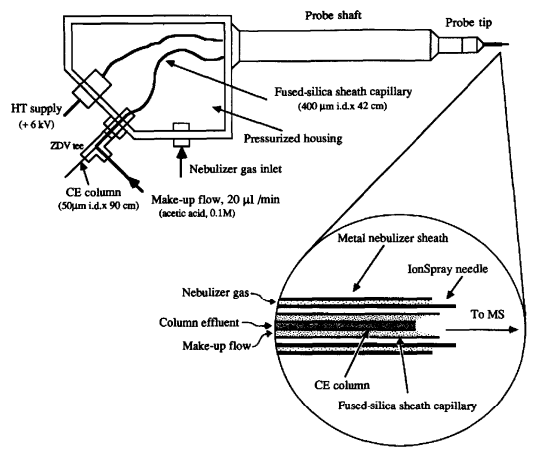Coaxial Sheath Solvent Ion Spray Interface - 1
Thibault and coworkers deserve the credit for being the first to combine the coaxial sheath solvent concept from the Smith group at Pacific Northwest National Laboratory with the ion spray approach of Henion and coworkers from Cornell University. Below their interface is depicted18,19.
 In the exploded view of the sprayer, one can recognize how the CE separation capillary, 50 µm i.d., and 350 µm o.d. is placed within another fused silica capillary 400 µm i.d via a ZDV T-union. Through the free leg of the T-union the sheath solvent, 0.1 M acetic acid is delivered at 20 µL/min. This 2-capillary assembly is shoved into a 20-gauge SST needle tube in a pressurized chamber. This needle is connected to the high voltage for electrospray. This needle is inside another tube through which the gas (air) from the over-pressurized chamber at 1-2 l/min helps to nebulize the liquid leaving the capillary assy.
In the exploded view of the sprayer, one can recognize how the CE separation capillary, 50 µm i.d., and 350 µm o.d. is placed within another fused silica capillary 400 µm i.d via a ZDV T-union. Through the free leg of the T-union the sheath solvent, 0.1 M acetic acid is delivered at 20 µL/min. This 2-capillary assembly is shoved into a 20-gauge SST needle tube in a pressurized chamber. This needle is connected to the high voltage for electrospray. This needle is inside another tube through which the gas (air) from the over-pressurized chamber at 1-2 l/min helps to nebulize the liquid leaving the capillary assy.
These authors report a sensitivity of 5 µM for the marine toxins they were interested in.
![]()
a
18P. Thibault al., Rapid Comm. Mass Spect., 5, 484 (1991).
19P. Thibault al., J. Chrom., 542, 483 (1991)
